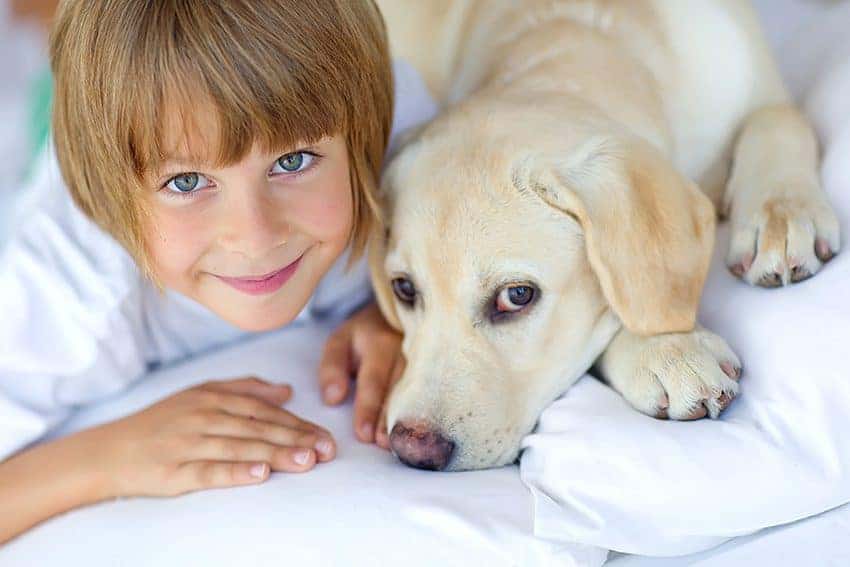
Children get more satisfaction from relationships with their pets and get on better with their animal companions than with their brothers or sisters, according to a new study.
Research from Cambridge University adds to increasing evidence that household pets may have a major influence on child development, and could have a positive impact on children’s social skills and emotional wellbeing.
”Anyone who has loved a childhood pet knows that we turn to them for companionship and disclosure, just like relationships between people,” says Matt Cassells, a Gates Cambridge Scholar at the Department of Psychiatry, who led the study. “We wanted to know how strong these relationships are with pets, relative to other close family ties. Ultimately, this may enable us to understand how animals contribute to healthy child development.”
This study, published in the Journal of Applied Developmental Psychology, involved surveying 12-year-old children from 77 families with one or more pets of any type and more than one child at home. Children reported strong relationships with their pets relative to their siblings, with lower levels of conflict and greater satisfaction in owners of dogs than other kinds of pets.
”Even though pets may not fully understand or respond verbally, the level of disclosure to pets was no less than to siblings,” says Cassels. “The fact that pets cannot understand or talk back may even be a benefit as it means they are completely non-judgmental.”
So, having a pet really does enhance a child’s life – but, along with the family dog or cat, which animals make the best furry friends for children of different ages?
Animal companions for all
While adults in the home should always take ultimate responsibility for any fur-covered family members – and if you’re a responsible pet owner, your children will follow your lead – with help and guidance, some animals can be jointly cared for. It’s very important to stress, however, that small animals are often more complex to feed and care for than a cat or dog, and require more looking after than a child can offer. So, while it’s lovely for children to enjoy the company of small pets, the responsibility for any animal’s wellbeing lies with adults. Here are some pets to consider.
Under 5s
Guinea pigs
The youngest members of the family should always be supervised with an animal. Guinea pigs make good first pets as they are gentle and friendly if handled correctly. Adults will have to teach youngsters how to behave around these shy but chatty rodents and how to handle them safely – as well as overseeing feeding and taking charge of cage-cleaning duties. Young children can still enjoy having GPs on their lap and feeding them some tasty Excel nuggets.
Under 12s
Hamsters, rabbits, rats, gerbils, degus
When teaching older children to care for small furries, it’s good to have a plan in place. Make a list of all pet-care responsibilities and discuss with your child why each task is important and what could happen to their pet if it is not done – for example, the animal could go hungry or get sick. Encourage them to learn as much as possible about their new pets to get them interested in all aspects of their care – maybe they can do a report on the animals for school, or help teach their friends about their pets. And, rather than telling them off for not cleaning out the gerbils’ cage, talk to your child about the difference they can make to their pet’s life, and how it will make their gerbils much happier to be in clean, snug bedding and why you are trusting them to care properly for their pet. Most children respond positively to this level of responsibility – but always keep a close eye on them.
Teenagers
Chinchillas
These beautiful, cuddly-looking creatures, which should always be kept in pairs, are incredibly appealing, but their care requirements are complex and they’re only really suitable as pets for adults or responsible teenagers looking for a couple of fluffy, active pals they can chill out with. While they enjoy lots of nap-time, when they’re awake, chinchillas rarely sit still. These lively rodents require plenty of space to exercise and need to be let out for a run at least once a day. Before allowing your chinchillas to run (under supervision) around the house, you need to be confident that you can catch them again, so some kind and patient chinchilla training will be required. Hours of fast-paced chinchilla fun will follow.
Ferrets
A pair of ferrets, which spend up to 20 hours a day sleeping, but are endlessly active and entertaining when awake, can make wonderful pets. Traditionally, ferrets live outdoors, but they can be kept as indoor pets. They will benefit from the largest enclosure you can provide so they have plenty of room to exercise and play. Ferrets need an insulated sleeping area, and lots of drainpipes and shelves to tunnel through and climb on. They like to sleep in hammocks and can also be trained to walk with a harness and lead. Young ferrets can be prone to biting, so first-time owners should look for ferrets that are at least a year old, have already been handled a lot and are less likely to bite. Naturally curious, ferrets interact readily with their human and can form strong bonds. Their feeding and health requirements are very specific, so some detailed research should be carried out before introducing fun-loving ferrets into your family’s life.
Sources: sciencedaily.com, bluecross.org.uk














